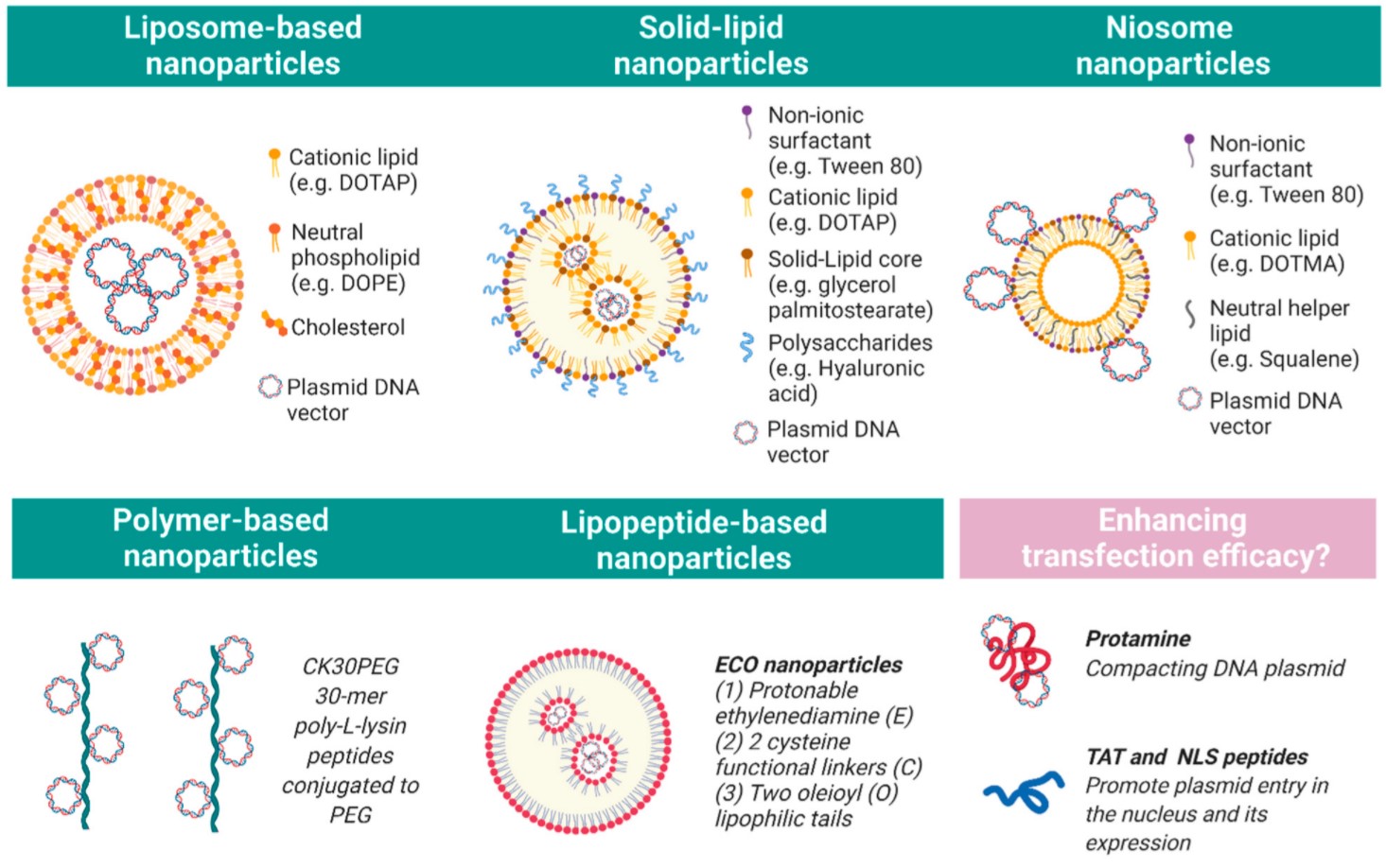Improving Vision: Viral and Non-Viral Gene Therapy Strategies for Inherited Retinal Disease
Inherited Retinal Diseases (IRDs) are a genetically heterogeneous group of conditions often leading to progressive vision loss and affecting different retinal cell types (Cremers et al. 2018, Toualbi et al. 2021). A gene therapy approach to improve vision relies on the delivery of normal genes to restore normal protein expression. The first FDA approval of an IRD gene therapy was granted in 2017 to Luxturna, developed by Sparks Therapeutics. Luxturna is a treatment for retinal dystrophy associated with biallelic RPE65 mutations known to be implicated in Leber Congenital Amaurosis (LCA2).
This approval opened the gates for a staggering number of gene therapies for different IRD indications. Currently, gene therapies targeting IRDs such as LCA phenotypes, Leber’s Hereditary Optic Neuropathy (LHON), Retinitis Pigmentosa, Stargardt Disease, and Choroideremia are in different stages of preclinical and clinical development worldwide.
LCA is considered the most severe form of IRD, having the earliest onset from birth and involving partial to complete blindness (Sato et al. 2020). LCA has a highly heterogeneous etiology, with mutations identified in a total of 19 genes leading to LCA1-LCA19 phenotypes. Because, similar to LAC, most IRDs are genetically heterogeneous, gene therapy approaches need to be tailored to address the specific underlying pathologies (Cremers et al. 2018). Currently, most gene therapies for LCA are based on DNA approaches and mainly leverage Adeno-Associated Virus (AAV) vectors for gene delivery. In fact, AAVs are used in most gene therapies for IRDs.
| Company/University | Gene Therapy | LCA Phenotype/Gene | Study Stage |
|---|---|---|---|
| Atsena Therapeutics Inc | SAR-439483 | LCA1/GUCY2D | Phase II |
| Case Western Reserve Univ | N/A | LCA2/RPE65 | Preclinical |
| IVERIC bio Inc | N/A | LCA10/CEP290 | Preclinical |
| MeiraGTx Holdings Plc | AAV-AIPL1 | LCA4/AIPL1 | Preclinical |
| MeiraGTx Holdings Plc | cevaretigene ritoparvovec | LCA2/ RPE65 | Phase II |
| Ocugen Inc | OCU-400 | /NR2E3 | Preclinical |
| Odylia Therapeutics Inc | N/A | LCA6/RPGRIP1 | Preclinical |
| State Univ System of Florida | N/A | LCA1/GUCY2D | Preclinical |
| Univ of Pennsylvania | N/A | LCA2/RPE65 | Phase I |
| U.S. National Institutes of Health | N/A | LCA7/CRX | Discovery |
Advantages and Disadvantages of Viral and Non-Viral DNA Delivery
AAV vectors have become a standard approach for delivering normal genes to improve vision in IRD cases. Several advantages, such as efficient gene delivery to retinal target cells (i.e., photoreceptors) and their demonstrated safety in human trials, have propelled the use of AAV vectors in IRD gene therapy (Trapani, 2019). Nevertheless, the main disadvantage of AAV vectors lies in their limited capacity to deliver large genes (i.e., >5 kb). In contrast, non-viral approaches based on plasmid DNA in complex with cationic lipids or polymers provide greater flexibility for delivering large genes. Nonetheless, compared to AAV vectors, non-viral delivery has not been as effective in inducing retinal gene expression.

“Figure 2. Key nanoparticles of interest for retinal non-viral gene therapy. Several chemical vehicles have been developed as plasmid DNA carriers, such as nanoparticles based on liposomes, solid lipids, niosomes, polymers, and lipopeptides (Created with BioRender.com (accessed on 1 February 2021)).” Retrieved without modifications from Toualbi et al. 2021, https://creativecommons.org/licenses/by/4.0/
Preclinical efforts to improve the delivery of plasmid DNA into retinal cells have focused on optimizing both vehicles (i.e., nanoparticle chemistry) and delivery methods (e.g., iontophoresis and optoporation). Several studies have evaluated the efficiency of gene delivery supported by lipid-, solid-lipid-, polymer-, and lipopetide-based nanoparticles in small animal models with variable success in achieving retinal expression (Toualbi et al. 2021). For example, Sun and colleagues delivered normal copies of the RPE65 and ABCA4 genes by using modified lipopeptide-based ECO nanoparticles (i.e., all-trans-retinylamine or a retinylamine analogue) for improved gene delivery into the retinal pigmented epithelium (RPE). These modified ECO/transgene nanoparticles in mice successfully targeted the RPE, inducing transgene expression (Sun et al. 2017, 2019). In the LCA2 (RPE65-/-) mouse model, subretinal administration of all-trans-retinylamine modified ECO/RPE65 nanoparticles induced RPE65 expression in the RPE and supported improved photoreceptor function that was long-lasting, with effects persisting up to 120 days after treatment (Sun et al. 2017).
Although various plasmid delivery methods have shown success inducing transgene expression in retinal cells, these studies have not progressed from small rodents to large animal models such as non-human primates (Toualbi et al. 2021). Therefore, while non-viral plasmid-based approaches to IRD gene therapy may provide critical benefits, such as delivering large genes and reduced inflammatory reactions, much work remains to be done in larger animal models to optimize their use.
Reference
Cremers, F. P. M., Boon, C. J. F., Bujakowska, K. & Zeitz, C. Special issue introduction: Inherited retinal disease: Novel candidate genes, genotype-phenotype correlations, and inheritance models. Genes (2018) doi:10.3390/genes9040215.
Sato, S. et al. Novel mutation identified in Leber congenital amaurosis - A case report. BMC Ophthalmol. (2020) doi:10.1186/s12886-020-01577-9.
Sun, D. et al. Targeted Multifunctional Lipid ECO Plasmid DNA Nanoparticles as Efficient Non-viral Gene Therapy for Leber’s Congenital Amaurosis. Mol. Ther. - Nucleic Acids (2017) doi:10.1016/j.omtn.2017.02.005.
Sun, D. et al. Non-viral Gene Therapy for Stargardt Disease with ECO/pRHO-ABCA4 Self-Assembled Nanoparticles. Mol. Ther. (2019) doi:10.1016/j.ymthe.2019.09.010.
Toualbi, L., Toms, M. & Moosajee, M. The landscape of non-viral gene augmentation strategies for inherited retinal diseases. International Journal of Molecular Sciences (2021) doi:10.3390/ijms22052318.
Trapani, I. Adeno-associated viral vectors as a tool for large gene delivery to the retina. Genes (Basel). (2019) doi:10.3390/genes10040287.
- Like (3)
- Reply
-
Share
About Us · User Accounts and Benefits · Privacy Policy · Management Center · FAQs
© 2025 MolecularCloud



